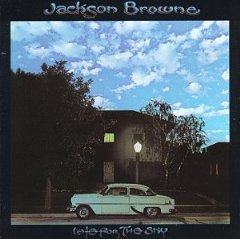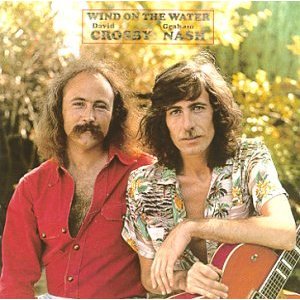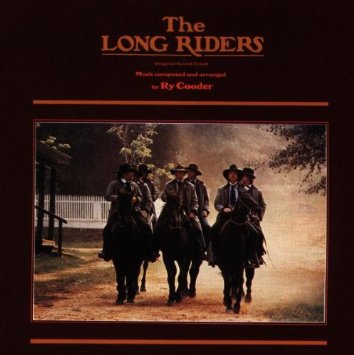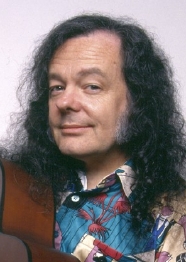Multi-instrumentalist David Lindley’s musical resume is simply incredible. He was a key member of the 1960’s eclectic psychedelic band Kaleidoscope, which was described by Led Zeppelin guitarist Jimmy Page as “my favorite band of all time – my ideal band.” He is arguably best known for his fretwork for Jackson Browne – for example, on the classic albums Late for the Sky and Running on Empty – and he also contributed to music by David Crosby and Graham Nash as part of The Mighty Jitters band, Warren Zevon, Linda Ronstadt and many, many others. Somehow he also found time for his own project, El Rayo-X, in the 1980s.
When you hear Lindley in concert, it’s easy to get the impression that he could pick up any stringed instrument – a saz baglama, a bouzouki, an oud, or a plain old guitar – and his magical fingers would make it sound great. And while he is best known for playing with other artists, his amazing talent particularly shines through when he is on his own.
This interview was done for a preview article for Lindley’s solo concert at the Lobero Theatre in Santa Barbara on 1/16/15. It was done by phone on 1/9/16.
Jeff Moehlis: What can we look forward to at the upcoming show?
David Lindley: I’m going to do some new stuff. It’s just me by myself. It’ll be good.
JM: I assume you’ll be bringing some exotic instruments with you?
DL: Yeah. I have some Hawaiian guitars, and an Irish bouzouki, a quarter-tone bouzouki, and I have an electric oud. Yeah, it’ll be good.
JM: I’ve alway been curious, did you ever have any formal musical training?
DL: There was some. I studied classical guitar with Frederick Noad, who was a teacher in L.A. And then I studied a little bit with Ergun Tamer – he’s a Turkish saz player that lives in Los Angeles. I studied a while with him. Other than that, I just learn from people by stealing, you know. It worked out real good.
JM: Was this when you were young?
DL: Yes it was. Yes, when I was in college. And then the saz, that was like twenty years ago or so.

JM: I’m a big fan of the band Kaleidoscope. How do you feel that band fit in with what else was going on in the late ’60’s?
DL: It worked out pretty well. The audiences in those days were ready for anything. In the ’60’s there was free-form radio, which played everything. You’d hear Buck Owens and George Jones, and then you’d hear John Coltrane, and then Andres Segovia. You know, it didn’t really matter all that much. It was part of the thing that it would be free-form, and you’d play what you want, and people wanted to hear everything. It was a great time for that, really great.
JM: And then, of course after that you got a gig playing with and touring with Jackson Browne. How did that happen? How did you end up playing with him?

DL: I met Jackson through a friend of mine. I met him at the CBS convention in Los Angeles. He was introduced to me as one of the writers of some of the songs that the Hour Glass did – the Hour Glass was the Allman Brothers. We’d been doing gigs with these guys in my friend’s club, The Magic Mushroom. Jackson was, God I don’t know, 19 or something. He was a big fan of The Kaleidoscope, and we were talking about stuff and I gave him a ride home. And then I ran into him in England, when I went to England to play with Terry Reid, and we did some stuff. A little bit before that I had played onstage with him at The Troubadour – me and Ned Doheny were playing with him. It worked out so well that he said, “We should probably do a band thing.” We kind of agreed. And then when I came back from England I looked him up, and the rest is history.
JM: It amazes me how busy you must’ve been in the ’70’s…
DL: Yeah, it was insane. I was playing with four bands – with Jackson, with Crosby and Nash, with Linda Ronstadt, and then with James Taylor. I would leave one tour and go on another one. Actually, for a while people were booking tours so that I could go out on the road with them. I really thought that was cool. I had two weeks off one year, and the rest of it was all on the road. You know the Dr. Jekyll and Mr. Hyde thing? I became Mr. Hyde, for a long time [laughs]. It was really insane.
JM: You mentioned Crosby and Nash. What was it like working with those guys at that time?

DL: Oh, it was fantastic. It was really wonderful. I got to play with Timmy Drummond, who used to play bass for James Brown. The band was fabulous. We went out as The Mighty Jitters. We played a lot of places. We played The Budokan in Japan… we played everywhere. A lot of that is a blur. I was playing with so many people. But playing with those guys was fabulous. Me and Crosby got to talk 12-string guitars and guitar building and stuff. He was such a cool guy, and still is.
You know, I haven’t seen those guys for maybe a year or so. I saw them in London – they came by Jackson’s concert, and we talked about all kinds of stuff. It was great to see them. Great to see Crosby still with us, you know. I remember right after he had his liver transplant, we were doing a benefit. He was sitting down – he had to sit down – we were at the side of the stage and I feel his elbow in my hip, and he said, “You know, it’s really good to be alive.” And he really meant it. It was a big moment for me, all that.
JM: Another artist you worked with who unfortunately isn’t with us anymore was Warren Zevon. It sounds like he was quite a character.
DL: He was a character. He’s the only person I know that actually kicked cockroaches in his house with a .44 Magnum. He would shoot them from across the room. He was a really good shot. And, especially, a .44 Magnum has a lot of recoil and stuff [laughs]… yeah, he was pretty amazing. Right up to the end he had this really black sense of humor. He really went out in style. I thought it was pretty amazing.
JM: You also did a lot of session work. Is there any session work that particularly stands out to you, that you’re particularly proud of?

DL: Yeah. I did a lot of stuff with Ry Cooder, did a lot of soundtracks. And I can remember several recording sessions with Etta James – I’d always been a fan of hers, and I got to play with her. And then I also got to play on the Trio album, which was Dolly Parton, Linda Ronstadt, and Emmylou Harris, and also played some sessions with Dolly, some old traditional music. Those really stand out. But there’s been so many, you know? The soundtrack stuff, yeah, I love the soundtrack stuff. The Long Riders, and Paris, Texas, all that. It was real fun.
JM: I assume it’s different to record for a soundtrack rather than playing with Jackson Browne, or that sort of thing. How did you approach the soundtracks?
DL: A lot of it was looking at the screen and playing to the screen. And usually we would have an idea of what we were going to play and we worked a lot of stuff out beforehand. Then we would watch the screen and there’s this stripe that goes across. It starts at the top and it goes all the way across the screen, and then it goes down to the bottom, and by the time it gets to the bottom you’d better be finished. This was right at the beginning of digital editing, so they got it down. Before that you’d have to time it and play it exactly metronomically, in a certain way.
They still did some of that for the Geronimo soundtrack that Ry did for Sony. I watched the string section, like a small chamber orchestra, play as if there was a click track. They played exactly the right thing, the exactly right length. Nothing was keeping time. It was all legato, it was beautiful stuff. And it was all conducted. I watched this happen, and I said, “Boy, that’s a whole lifetime of study, how to do that.” I was impressed – I was blown away. And I get up there, and said, “OK, let’s do this.” You know, I’d improvise and kind of screw around, and then, “How’s that? How’s that sound?” So it would be classically trained musicians and then us. There was a big difference. There’s so many real studio musicians who can do that stuff, and they only have to do it once. They read it – it’s written out for them – and they sit there and they read it and they play it beautifully, and with feeling and in tune, and they only do it once.
JM: What’s in the works right now?
DL: I’m working on my own new CD right now, so I’m kind of in studio mode. It’s working out really good. That’s kind of taking up a lot of energy and time. I’m also playing with my daughter. We’re going over songs and we’re writing stuff for this CD, and getting to play together. It’s so good playing with her. She’s such a killer. I’ve been doing that.
I’m in Spokane, Washington right now. We’re in kind of survival mode, because it’s supposed to be snowing. They were supposed to be getting hammered, and they didn’t. So it’s making them all nervous [laughs], and it’s making us nervous, too. We’re going to be up her for couple more days, and then we go back to California. But it gets down to, like, -5 and stuff up here, -13 [JM: a bit exaggerated]. I had to go by REI and buy some gloves and a Norwegian hat.
JM: You’re not in California anymore, right?
DL: [laughs] Hey, you’re not in California [laughs]. Yeah, it’s a real reality check, too. And everybody’s used to it here. They’re all fine, they’re just fine. We look like deer in the headlights.
JM: When you first decided to pursue a solo career in the early 80’s, you’d already been a professional musician for a dozen years or so. What prompted you to pursue a solo career at that time?
DL: It was the way I started. I started actually playing by myself, five-string banjo, guitar, and fiddle and stuff. I was really intrigued by people like Mike Seeger, who would take a bunch of instruments and do a one-man show. And there was a guy in our area, who was from back east – his name was Mike McClellan, and he used to play at a place called The Cat’s Pajamas. I used to go see him play, and he was a multi-instrumentalist.
And around that same time there was a guy named Sandy Bull. Sandy would play all kinds of stuff. I finally got to meet him and know him. He was a big inspiration, too. But I grew up going to the Ash Grove in Los Angeles to see people like Doc Watson and Mance Lipscomb and Son House, Fred McDowell, and all these solo players. Sabicas, the great flamenco guitarist, he was a solo artist, too. He played by himself, and a lot of the flamenco guitarists – Carlos Montoya – and the classical guitarists – Segovia, Julian Bream – they all played by themselves. So it was a very natural thing. And then people started doing it a lot. I went to see Leo Kottke, and J.J. Cale, and I said, “Shit, I’m gonna do this.” And it worked out good. I like it a lot because I can change courses in midstream, and I can change anything to however I want it, the form of it and everything. It’s good. It opens up lots of things.

JM: You mentioned Sandy Bull, who seems not to be very well known these days. Do you have any Sandy Bull stories that you’re willing to share?
DL: Yeah, I was playing with The Kaleidoscope in San Francisco, and I met this girl who I didn’t know was his girlfriend. She was very cool, and I went over to her house, and there was Sandy’s room. He had a room there, and he had all his instruments in there, and I went, “Oh no, man, what am I getting into?” [laughs] And then I got to meet and talk to him, and I spent more time talking to Sandy than anything else.
He had a baritone guitar – the first time I’d ever seen one. It was a Fender six-string bass, and he put lighter strings on it. I had never seen that before, and I played that and it just opened up by brain. So I bought a six-string bass and I put light strings on it, and I made a baritone guitar because of what I’d seen him do. And about the same time, John Sebastian was doing the same thing. I think John was inspired by Sandy as well, but he may not have been. Up until then, there was a guy named Link Wray who played a baritone guitar, Ozzie Nelson played a baritone guitar on Rick Nelson’s early recordings. It had been around for a while, and I think Sandy learned about it from other people. But he was the guy who actually played it and I heard it, and I said, “Oh yeah, there you go. That’s a good thing.” So he was responsible for that, and also for playing the oud, a lot of it. Everybody that I ever met, that I’ve ever heard, has been an influence on me. It all goes in there, and it will come out at times that I don’t expect it to.
JM: It always blows me away to hear Sandy Bull play the Carmina Burana on a banjo. [both laugh]
DL: And he would play Brazilian Luiz Bonfa tunes, and he would play them on the oud. He would do all this stuff. Seeing him play, and listening to him play, was like a license to kill, double-o 7. You can do anything you want. And once that was established, it was like another whole world opened up. You can play what you want on what you want – there’s no rules. And it was Sandy primarily that was responsible for that.
JM: Another guitar that I’ve been listening to recently is Robbie Basho. Did you interact with him?
DL: Yeah, I knew Robbie. He was great. Kaleidoscope played gigs with him. He was fabulous. He was so good, and a character, too. I also got to meet John Fahey, who shared an apartment with a guy that played dobro in the band I was in, the bluegrass band. Fahey, boy… man… The greatest song title guy in the world. He had the greatest song titles. He was so into it, and he could make anything into a guitar piece.
JM: There was the singing bridge [“The Singing Bridge of Memphis, Tennessee”, from The Yellow Princess].
DL: Yeah, and the Great San Bernadino Birthday Party. He was amazing, and kind of a Berkeley guy at the time. We’d run into him, we’d run into all kinds of people. And Richie Havens – I got to know him. He was one of those people that did the whole thing by himself.
JM: Last question – where do you buy your stage clothes?
DL: [laughs] Some of them, especially the shoes, came from a place called New Bonds – A Finer Reflection of You. They had stuff that I’ve never seen in my life, ever. The rest of it was stuff that I would find in thrift stores, since the 70’s because I started collecting shirts and pants and stuff like that in the ’70’s. I got all the great disco stuff. People hated it, and I said, “Oh no, man, this is art!” I have an actualy shirt that has John Travolta dancing down a pathway of stars in the sky, and he’s in that pose where he’s got his finger pointed up to the sky, and he has no face. It’s one of the best things I’ve ever seen. So good. And then I figured out all the brands that were the really demented, strange ones, and I bought a bunch of those. I have over 200 shirts now. It’s one of those things you can’t stop, ever.


Discussion
No comments for “Interview: David Lindley”